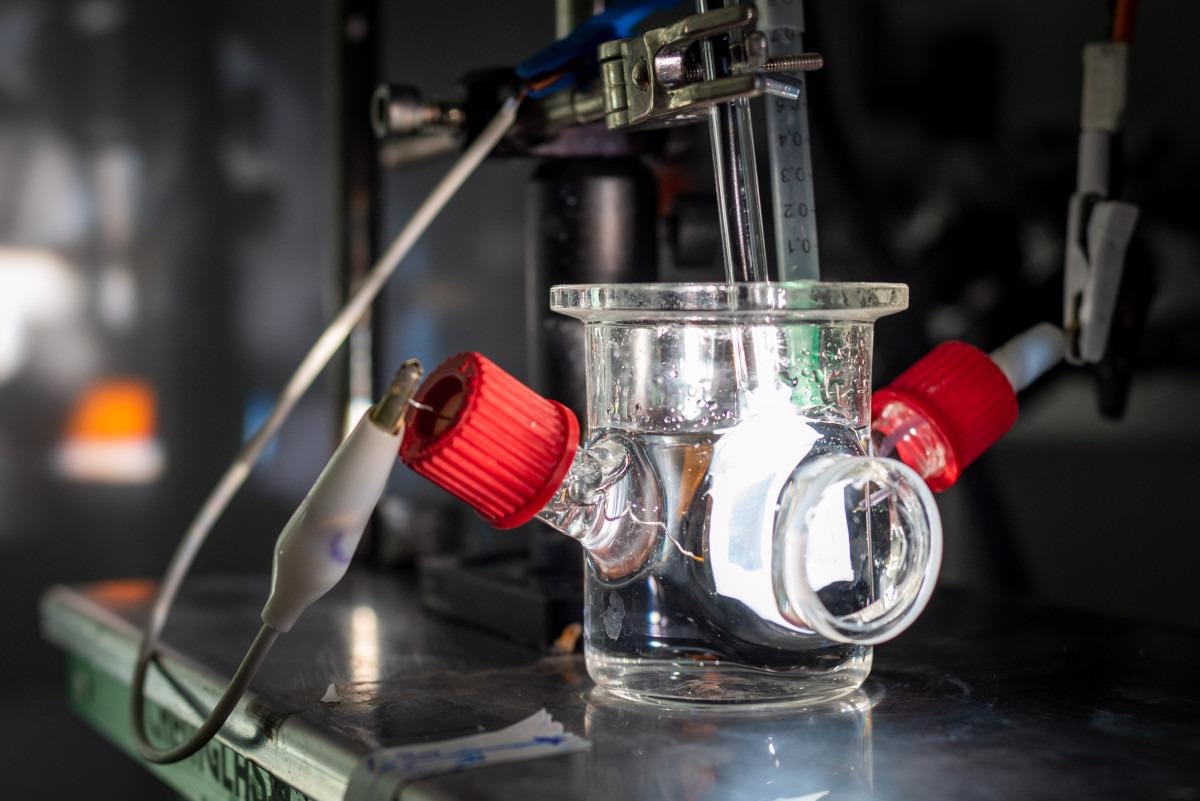A group of researchers has built a new artificial photosynthesis device component with extraordinary longevity and stability as it selectively turns sunlight and carbon dioxide into two favorable sources of renewable fuels — hydrogen and ethylene.
 A model solar fuels device called a photoelectrochemical cell. A research team led by Francesca Toma, a staff scientist at the Liquid Sunlight Alliance in Berkeley Lab’s Chemical Sciences Division, designed the model. (Image Credit: Thor Swift/Berkeley Lab).
A model solar fuels device called a photoelectrochemical cell. A research team led by Francesca Toma, a staff scientist at the Liquid Sunlight Alliance in Berkeley Lab’s Chemical Sciences Division, designed the model. (Image Credit: Thor Swift/Berkeley Lab).
The group’s findings, recently reported in the journal Nature Energy, show how the device deteriorates with use, and then show how to mitigate it. The researchers also offer a new perspective into how electrons and charge carriers, known as “holes,” contribute to deterioration in artificial photosynthesis.
By understanding how materials and devices transform under operation, we can design approaches that are more durable and thus reduce waste.
Francesca Toma, Senior Study Author and Staff Scientist, Liquid Sunlight Alliance and Chemical Sciences Division, Berkeley Lab
For the present study, Toma and her team engineered a model solar fuel device called a photoelectrochemical (PEC) cell composed of copper(I) oxide or cuprous oxide (Cu2O), a favorable artificial photosynthesis material.
For a long time, cuprous oxide has mystified scientists, because the strength of the material — its high reactivity to light — is also its weakness, as light causes the material to degrade within a few minutes of exposure.
But regardless of its instability, Cu2O is one of the most ideal candidate materials for artificial photosynthesis as it is fairly affordable and has appropriate characteristics for capturing visible light.
To comprehend in a better manner how to enhance the working conditions of this favorable material, Toma and her team closely examined the crystal structure of Cu2O before and after use.
Electron microscopy experiments at the Molecular Foundry verified that Cu2O rapidly oxidizes or corrodes within minutes of exposure to water and light. In artificial photosynthesis research, scientists have usually used water as the electrolyte in the reduction of carbon dioxide into renewable fuels or chemicals, such as hydrogen and ethylene — but water comprises hydroxide ions, which causes instability.
But another experiment, this time using a process known as ambient pressure X-ray photoelectron spectroscopy (APXPS) at the Advanced Light Source, showed a surprising clue: Cu2O corrodes even quicker in water comprising hydroxide ions, which are negatively charged ions containing an oxygen atom bound to a hydrogen atom.
“We knew it was unstable — but we were surprised to learn just how unstable it really is,” said Toma. “When we began this study, we wondered, maybe the key to a better solar fuels device isn’t in the material by itself but in the overall environment of the reaction, including the electrolye.”
This demonstrates that hydroxides contribute to corrosion. On the other hand, we reasoned that if you eliminate the source of corrosion, you eliminate corrosion.
Guiji Liu, First Study Author and LiSA Project Scientist, Chemical Sciences Division, Berkeley Lab
Uncovering Unexpected Clues to Corrosion
In electronic devices, electron-hole pairs divide into electrons and holes to produce charge. But once divided, if electrons and holes are not used to produce electricity, such as in a photovoltaic device that changes sunlight into electricity, or to carry out a reaction in an artificial photosynthesis device, they can react with the material and break it down.
In artificial photosynthesis, this recombination can destroy Cu2O if it is not correctly controlled. Researchers had long believed that electrons were the only ones to blame for the corrosion of Cu2O.
But to Toma’s and Liu’s astonishment, computer simulations done at the National Energy Research Scientific Computing Center (NERSC) revealed that holes also have a part to play.
Before our study, most people assumed light-induced degradation in cuprous oxide was mainly caused by electrons, not holes.
Guiji Liu, First Study Author and LiSA Project Scientist, Chemical Sciences Division, Berkeley Lab
The simulations also implied a possible workaround to cuprous oxide’s inherent instability: a Cu2O PEC coated with silver on top and gold/iron oxide beneath. This “Z scheme,” which is stirred by the electron transfer that occurs in natural photosynthesis, should form a “funnel” that transmits holes from Cu2O to the gold/iron oxide “sink.”
Furthermore, the variety in materials at the interface should steady the system by delivering extra electrons to recombine with the holes of the Cu2O, explained Toma.
To confirm their simulations, the team engineered a physical model of a Z-scheme artificial photosynthesis device at Toma’s LiSA lab at Berkeley Lab. To their surprise, the device created hydrogen and ethylene with unparalleled selectivity — and for over 24 hrs.
“This is a thrilling result,” said Toma.
We hope that our work encourages people to design strategies that adapt to the intrinsic features of semiconducting materials in artificial photosynthesis devices.
Guiji Liu, First Study Author and LiSA Project Scientist, Chemical Sciences Division, Berkeley Lab
The scientists are keen to continue their work on creating new solar fuel devices for liquid fuels production by using their new method.
Understanding how materials transform while they are functioning in an artificial photosynthesis device can enable preventive repair and prolonged activity.
Francesca Toma, Senior Study Author and Staff Scientist, Liquid Sunlight Alliance and Chemical Sciences Division, Berkeley Lab
The other co-authors include Fan Zheng, Junrui Li, Guosong Zeng. Yifan Ye, David Larson, Junko Yano, Ethan Crumlin, Joel Ager and Lin-wang Wang.
The Liquid Sunlight Alliance is a DOE Energy Innovation Hub. The Molecular Foundry, Advanced Light Source, and NERSC are user facilities at Berkeley Lab.
This study received support from the DOE Office of Science.
Journal Reference:
Liu, G., et al. (2021) Investigation and mitigation of degradation mechanisms in Cu2O photoelectrodes for CO2 reduction to ethylene. Nature Energy. doi.org/10.1038/s41560-021-00927-1.